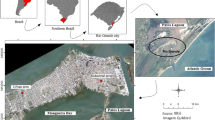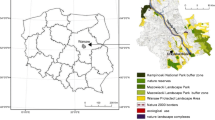Abstract
Size distribution (fine and coarse fraction) and solubility distribution (extracted and residual fraction) of 20 elements (As, Ba, Be, Cd, Co, Cu, Fe, Li, Mn, Pb, Ni, Rb, S, Sb, Se, Sn, Sr, Ti, Tl, V) in atmospheric particulate matter (PM) were determined during a 5-year field study carried out in the Po Valley (peri-urban area of Ferrara, in Northern Italy). By studying the contribution of the two size fractions and the two solubility fractions to the atmospheric concentration of each element, it was possible to obtain interesting information about the variability of PM sources, to assess the role played by atmospheric stability in determining pollution episodes, and to obtain an estimate of the bio-accessible fraction. Atmospheric stability is confirmed to be one of the main causes of atmospheric pollution in this area and is to be responsible for the pronounced winter increase in both PM and elemental concentration. Long-range transport of natural and polluted air masses caused temporary increases in PM and elemental concentration, while local industrial emission seemed to play a secondary role. Regulated elements were well below their concentration limit, but many toxic elements were in the form of fine particles and soluble chemical species, more accessible to the environment, and the human body.






Similar content being viewed by others
References
Al-Masri MS, Al-Kharfan K, Al-Shamali K (2006) Speciation of Pb, Cu and Zn determined by sequential extraction for identification of air pollution sources in Syria. Atmos Environ 40:753–761
Almeida SM, Pio CA, Freitas MC, Reis MA, Trancoso MA (2006) Source apportionment of atmospheric urban aerosol based on weekdays/weekend variability: evaluation of road re-suspended dust contribution. Atmos Environ 40:2058–2067
Argyropoulos G, Manoli E, Kouras A, Samara C (2012) Concentrations and source apportionment of PM10 and associated major and trace elements in the Rhodes Island, Greece. Sci Total Environ 432:12–22
Argyropoulos G, Grigoratos T, Voutsinas M, Samara C (2013) Concentrations and source apportionment of PM10 and associated elemental and ionic species in a lignite-burning power generation area of southern Greece. Environ Sci Pollut Res. doi:10.1007/s11356-013-1721-y
Armiento G, Inglessis M, Mazziotti Tagliani S, Montereali MR, Nardi E, Palleschi S, Piga L, Sacco F, Silvestroni L, Gianfagna A (2013) A comprehensive approach to the investigation of atmospheric particulate PM2.5: preliminary results. Periodico di Mineralogia 82:199–216
Barrett PM, Resing JA, Buck NJ, Buck CS, Landing WM, Measures CI (2012) The trace element composition of suspended particulate matter in the upper 1000 m of the eastern North Atlantic Ocean: A16N. Mar Chem 142–144:41–53
Birmili W, Allen AG, Bary F, Harrison RM (2006) Trace metal concentrations and water solubility in size-fractionated atmospheric particles and influence of road traffic. Environ Sci Technol 40:1144–1153
Canepari S, Cardarelli E, Giuliano A, Pietrodangelo A (2006a) Determination of metals and non volatile ions in airborne particulate matter by a new two-step sequential leaching procedure. Part A: experimental design and optimisation. Talanta 69:581–587
Canepari S, Cardarelli E, Pietrodangelo A, Strincone M (2006b) Determination of metals, metalloids and non volatile ions in airborne particulate matter by a new two-step sequential leaching procedure. Part B: validation on equivalent real samples. Talanta 69:588–595
Canepari S, Perrino C, Olivieri F, Astolfi ML (2008) Characterisation of the traffic sources of PM through size-segregated sampling, sequential leaching and ICP analysis. Atmos Environ 42:8161–8817
Canepari S, Pietrodangelo A, Perrino C, Astolfi ML, Marzo ML (2009a) Enhancement of source traceability of atmospheric PM by elemental chemical fractionation. Atmos Environ 43:4754–4765
Canepari S, Perrino C, Astolfi ML, Catrambone M, Perret D (2009b) Determination of soluble ions and elements in ambient air suspended particulate matter: inter-technique comparison of XRF, IC and ICP for sample-by-sample quality control. Talanta 77:1821–1829
Canepari S, Astolfi ML, Moretti S, Curini R (2010) Comparison of extracting solutions for elemental fractionation in airborne particulate matter. Talanta 82:834–844
Canepari S, Padella F, Astolfi ML, Marconi E, Perrino C (2013) Elemental concentration in atmospheric particulate matter: estimation of nanoparticle contribution. Aerosol Air Qual Res. doi: 10.4209/aaqr.2013.03.0081. In press.
Carbone C, Decesari S, Mircea M, Giulianelli L, Finessi E, Rinaldi M, Fuzzi S, Marinoni A, Duchi R, Perrino C, Sargolini T, Vardè M, Sprovieri F, Gobbi GP, Angelini F, Facchini MC (2010) Size-resolved aerosol chemical composition over the Italian peninsula during typical summer and winter conditions. Atmos Environ 44:5269–5278
Cho S-H, Tong H, McGee JK, Baldauf RW, Todd Krantz Q, Ian Gilmour M (2009) Comparative toxicity of size-fractionated airborne particulate matter collected at different distances from an urban highway. Environ Health Perspect 117:1682–1689
Dos Santos M, Gómez D, Dawidowski L, Gautier E, Smichowski P (2009) Determination of water-soluble and insoluble compounds in size classified airborne particulate matter. Microchem J 91:133–139
Draxler RR, Rolph GD (2010) HYSPLIT (HYbrid Single-Particle Lagrangian Integrated Trajectory) Model access via NOAA ARL READY Website (http://ready.arl.noaa.gov/HYSPLIT.php). NOAA Air Resources Laboratory, Silver Spring, MD
Dutkiewicz VA, Qureshi S, Husain L, Schwab JJ, Demerjian KL (2006) Elemental composition of PM2.5 aerosols in Queens, New York: evaluation of sources of fine-particle mass. Atmos Environ 40:S347–S359
EC: EU Arsenic, cadmium, mercury, nickel and polycyclic aromatic hydrocarbons in ambient air Directive 2004/107/EC, 2004
EC: EU air quality directive 2008/50/EC, 2008
Fernandez Espinosa AJ, Ternero Rodriguez M, Barragan de la Rosa FJ, Jimenez Sanchez JC (2002) A chemical speciation of trace metals for fine urban particles. Atmos Environ 36:773–780
Gietl JK, Lawrence R, Thorpe AJ, Harrison RM (2010) Identification of brake wear particles and derivation of a quantitative tracer for brake dust at a major road. Atmos Environ 44:141–146
Harrison RM, Yin J (2000) Particulate matter in the atmosphere: which particle properties are important for its effects on health? Sci Total Environ 249:85–101
Heal MR, Hibbs LR, Agius RM, Beverland IJ (2005) Total and water-soluble trace metal content of urban background PM10, PM2.5 and black smoke in Edinburgh, UK. Atmos Environ 39:1417–1430
Hueglin C, Gehrig R, Baltensperger U, Gysel M, Monn C, Vonmont H (2005) Chemical characterisation of PM2.5, PM10 and coarse particles at urban, near-city and rural sites in Switzerland. Atmos Environ 39:637–651
Li R, Wiedinmyer C, Hannigan MP (2013) Contrast and correlations between coarse and fine particulate matter in the United States. Sci Total Environ 456–457:346–358
Limbeck A, Wagner C, Lendl B, Mukhtar A (2012) Determination of water soluble trace metals in airborne particulate matter using a dynamic extraction procedure with online inductively coupled plasma optical emission spectrometric detection. Anal Chim Acta 750:111–119
Marcazzan GM, Vaccaro S, Valli G, Vecchi R (2001) Characterisation of PM10 and PM2.5 particulate matter in the ambient air of Milan (Italy). Atmos Environ 35:4639–4650
Marenco F, Bonansoni P, Carlzolari F, Ceriani M, Chiari M, Cristofanelli P, D’Alessandro A, Fermo P, Lucarelli F, Mazzei F, Nava S, Piazzalunga A, Prati P, Valli G, Vecchi R (2006) Characterization of atmospheric aerosols at Monte Cimone, Italy, during summer 2004: source apportionment and transport mechanisms. J Geophys Res 111, D24202
Marmur A, Park S-K, Mulholland JA, Tolbert PE, Russell AG (2006) Source apportionment of PM2.5 in the southeastern United States using receptor and emissions-based models: Conceptual differences and implications for time-series health studies. Atmos Environ 40:2533–2551
Mukhtar A, Limbeck A (2013) Recent developments in assessment of bio-accessible trace metal fractions in airborne particulate matter: a review. Anal Chim Acta 774:11–25
Oberdörster G (2001) Pulmonary effects of inhaled ultrafine particles. Int Arch Occup Environ Health 74:1–8
Oberdörster G, Oberdörster E, Oberdörster J (2005) Nanotoxicology: an emerging discipline evolving from studies of ultrafine particles. Environ Health Perspect 113:823–839
Öztürk F, Zararsız A, Dutkiewicz VA, Husain L, Hopke PK, Tuncel G (2009) Temporal variations and sources of Eastern Mediterranean aerosols based on a 9-year observation. Atmos Environ 61:463–475
Pant P, Harrison RM (2013) Estimation of the contribution of road traffic emissions to particulate matter concentrations from field measurements: a review. Atmos Environ. doi:10.1016/j.atmosenv.2013.04.028
Perrino C, Canepari S, Catrambone M, Dalla Torre S, Rantica E, Sargolini T (2009) Influence of natural events on the concentration and composition of atmospheric particulate matter. Atmos Environ 43:4766–4779
Perrino C, Canepari S, Pappalardo S, Marconi E (2010) Time-resolved measurements of water-soluble ions and elements in atmospheric particulate matter for the characterization of local and long-range transport events. Chemosphere 80:1291–1300
Perrino C, Catrambone M, Dalla Torre S, Rantica E, Sargolini T, Canepari S (2013) Seasonal variations in the chemical composition of particulate matter: a case study in the Po Valley. Part I: macro-components and mass closure. Environ Sci Poll Res. doi:10.1007/s11356-013-2067-1. In press.
Pey J, Querol X, Alastuey A (2009) Variations of levels and composition of PM10 and PM2.5 at an insular site in the Western Mediterranean. Atmos Res 94:285–299
Qureshi S, Dutkiewicz VA, Khan AR, Swami K, Yang KX, Husain L, Schwab JJ, Demerjian KL (2006) Elemental composition of PM2.5 aerosols in Queens, New York: solubility and temporal trends. Atmos Environ 40:S238–S251
Reche C, Moreno T, Amato F, Viana M, van Drooge BL, Chuang H-C, Bérubé K, Jones T, Alastuey A, Querol X (2012) A multidisciplinary approach to characterise exposure risk and toxicological effects of PM 10 and PM 2.5 samples in urban environments. Ecotoxicol Environ Saf 78:327–335
Rodrıguez S, Querol X, Alastuey A, Viana M, Alarcon M, Mantilla E, Ruiz CR (2004) Comparative p M10–PM2.5 source contribution study at rural, urban and industrial sites during PM episodes in Eastern Spain. Sci Total Environ 328:95–113
Sato K, Tamura T, Furuta N (2008) Partitioning between soluble and insoluble fractions of major and trace elements in size-classified airborne particulate matter collected in Tokyo. J Environ Monit 10:211–218
Sillanpää M, Saarikoski S, Hillamo R, Pennanen A, Makkonen U, Spolnikc Z, Van Grieken R, Koskentalo T, Salonen RO (2005) Chemical composition, mass size distribution and source analysis of long-range transported wildfire smokes in Helsinki. Sci Total Environ 350:119–135
Svenningsson IB, Hansson H-C, Wiedensohler A, Ogren JA, Noone KJ, Hallberg A (1992) Hygroscopic growth of aerosol particles in the Po Valley. Tellus 44B:556–569
Vecchi R, Marcazzan G, Valli G, Ceriani M, Antoniazzi C (2004) The role of atmospheric dispersion in the seasonal variation of PM1 and PM2.5 concentration and composition in the urban area of Milan (Italy). Atmos Environ 38:4437–4446
Viana M, Kuhlbusch TAJ, Querol X, Alastuey A, Harrison RM, Hopke PK, Winiwarter W, Vallius M, Szidat S, Prévôt ASH, Hueglin C, Bloemen H, Wåhlin P, Vecchi R, Miranda AI, Kasper-Giebl A, Maenhaut W, Hitzenberger R (2008) Source apportionment of particulate matter in Europe: a review of methods and results. Aerosol Sci 39:827–849
Voutsa D, Samara C (2002) Labile and bioaccessible fractions of heavy metals in the airborne particulate matter from urban and industrial areas. Atmos Environ 36:3583–3590
Acknowledgments
This study has been funded by HERA s.p.a. We thank the Ferrara Department of the Environmental Protection Agency of the Emilia Romagna for RH and SR data. Thanks are also due to Dr. Mariano Puente Garcia for his valuable suggestions and to Dr. Chiara Giovannelli for her collaboration in the experimental phase. M Catrambone, S. Dalla Torre, E. Rantica, and T. Sargolini, of CNR-IIA are gratefully acknowledged for running the sampling activity.
Author information
Authors and Affiliations
Corresponding author
Additional information
Responsible editor: Céline Guéguen
Electronic supplementary material
Below is the link to the electronic supplementary material.
Supplementary Material 1
(DOCX 2688 kb)
Supplementary Material 2
(DOCX 19 kb)
Rights and permissions
About this article
Cite this article
Canepari, S., Astolfi, M.L., Farao, C. et al. Seasonal variations in the chemical composition of particulate matter: a case study in the Po Valley. Part II: concentration and solubility of micro- and trace-elements. Environ Sci Pollut Res 21, 4010–4022 (2014). https://doi.org/10.1007/s11356-013-2298-1
Received:
Accepted:
Published:
Issue Date:
DOI: https://doi.org/10.1007/s11356-013-2298-1




